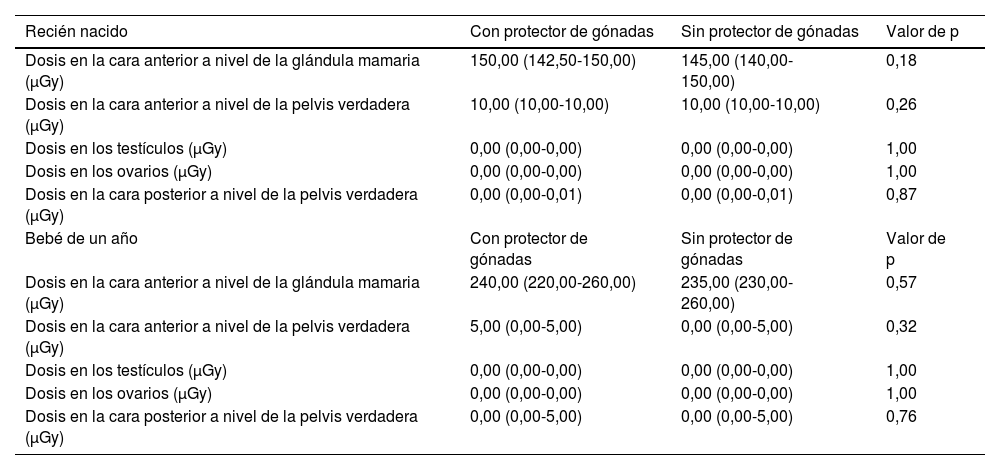Comparar las dosis de radiación en las gónadas con y sin protector gonadal y optimizar el uso de estos protectores al realizar radiografías de tórax a lactantes.
Materiales y métodosSe utilizan 2 maniquíes antropomórficos pediátricos, un sistema de rayos X KXO-50SS/DRX-3724HD, y un sistema de radiografía digital CALNEO Smart C12, con y sin protector de gónadas durante la realización de radiografías de tórax. Se coloca un dosímetro cutáneo en tiempo real en el sistema de rayos X y se inserta un dosímetro cutáneo en tiempo real en la cara anterior de la glándula mamaria, en la cara anterior y posterior de la pelvis verdadera, y en los ovarios y testículos. El sistema de rayos X se irradia 15 veces con maniquíes, con y sin el protector de gónadas. Se comparan los valores de las dosis de entrada del paciente medidos por el dosímetro cutáneo en tiempo real para cada maniquí, con y sin el protector de gónadas.
ResultadosLos valores medios de las dosis a la entrada del paciente medidos para la cara anterior a nivel de la pelvis verdadera, con y sin el protector, son 10,00 y 5,00μGy en el recién nacido, y 10,00 y 0,00μGy al año, respectivamente. Los valores medios de las dosis a la entrada del paciente medidos para la cara posterior a nivel de la pelvis verdadera con y sin el protector son de 0,00 y 0,00μGy tanto en el recién nacido como al año, respectivamente. Las dosis a la entrada del paciente medidas no se pueden detectar en los ovarios y los testículos ni con el protector ni sin él. No se observan diferencias significativas en los valores de las dosis a la entrada del paciente medidas en la cara anterior y posterior de la pelvis, los ovarios y los testículos en el recién nacido y al año, con y sin el protector (p>0,05).
ConclusionesNo se observaron diferencias significativas en las mediciones de las dosis de gónadas con y sin el protector gonadal durante la realización de una radiografía de tórax en los lactantes. Creemos que el uso del protector gonadal no es necesario.
To compare gonad doses with and without a gonad protector and to optimize the use of gonadal protectors in infants thorax radiography.
Materials and methodsTwo pediatric anthropomorphic phantoms are used: an X-ray system for KXO-50SS/DRX-3724HD, and a digital radiography system for CALNEO Smart C12, with and without a gonad protector during infants thorax radiography. A real time skin dosimeter is placed on the X-ray system, and a real time skin dosimeter is inserted on the front side of the mammary gland, the front and back sides of the true pelvis level, and on the ovaries and testes. The X-ray system is irradiated 15 times using phantoms with and without a gonad protector. The measured entrance patient doses values of for the real time skin dosimeter are compared for each phantom, with and without the gonad protector.
ResultsThe medium of measured entrance patient doses values for front side dose of the true pelvis level with and without the protector are 10.00 and 5.00μGy at newborn, and 10.00 and 0.00μGy at one year, respectively. The medium of measured entrance patient doses values for the back side dose of the true pelvis level with and without the protector are 0.00 and 0.00μGy at both newborn one year, respectively. The measured entrance patient doses cannot be detected in the ovaries and testes with or without the protector. No significant differences are observed in the measured entrance patient doses values for the front and back side doses of the pelvis, ovaries, and testes at newborn and one year, with and without the protector (p>0.05).
ConclusionsNo significant difference was observed in gonad dose measurements with and without the gonad protector during infants chest radiography. We believe that gonadal protector wearing is not necessary.











